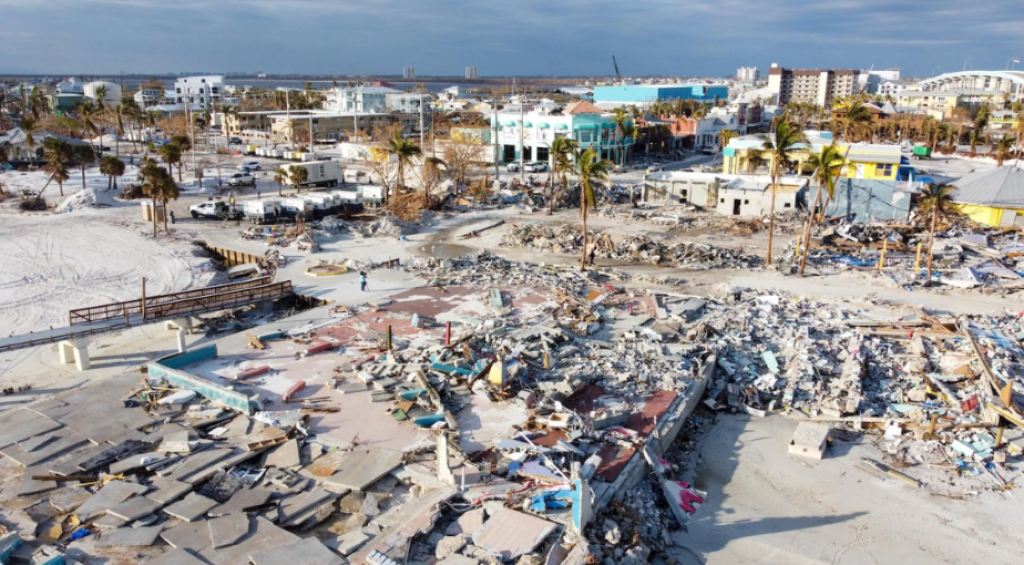Climate change is intensifying, generating more frequent and severe extreme weather events. These are in turn affecting the economy through a range of mechanisms, including supply, demand, and financial channels, and over time horizons relevant for monetary policymakers. This first in a three-column series sets out a framework to assist central banks in assessing and understanding the macroeconomic effects of acute physical impacts from climate change.
As severe weather events (acute physical hazards) intensify, becoming more frequent and more geographically widespread (IPCC 2023), their macroeconomic effects will intensify in both the short and long run. Global damages from weather-related hazards have continued to rise in recent decades. These impacts are increasingly affecting the path of output and inflation, making them a relevant consideration for monetary policymakers. A recent report by the Network for Greening the Financial System (NGFS 2024a) sets out a framework to assist central banks in assessing and understanding the macroeconomic effects of acute physical impacts from climate change.
No two events will affect the economy in the same way
As the global climate changes, we are increasingly seeing severe weather events such as heatwaves, landslides, floods, wildfires, and storms, and chronic climate events such as rising sea levels and higher average temperatures.
Modelling the economic impacts of climate change is challenging, requiring the integration of two disciplines: climate science and economics. This requires us to link our assessment of physical hazards to macroeconomic outcomes. 1
The extent to which physical damages translate into economic and financial impacts depends on several factors:
- First, the nature and type of the hazard. Some hazards, like storms and floods, are of short duration but can cause widespread and long-lasting physical destruction. Other hazards, like droughts, are slow to unfold and the true extent of the damages may take months to be fully visible.
- Second, the level of economic activity at the location where it occurs. This includes the total value of assets (such as productive capital, infrastructure, and housing) and socioeconomic elements (such as population and jobs) that are exposed to a hazard.
- Third, the vulnerability of assets and economic activity to physical events, reflecting construction quality, disaster preparedness, and response capacity. For example, a tropical cyclone in an advanced economy may end up having a smaller economic impact than a similar event in a less developed economy if reconstruction efforts in the aftermath of that event are better and more rapid. The availability of private insurance and a government’s ability and willingness to provide fiscal support are important determinants of overall economic outcomes. Indeed, more frequent and severe weather events can diminish fiscal capacity and impair insurance provision, which can further increase the impact of shocks, particularly in emerging market and developing economies (Noy 2009).
Negative impacts from severe weather events can affect the economy with supply, demand, and financial channels amplifying and propagating the effects of the initial shock.
Figure 1 Flow chart of potential channels


Source: NGFS (2024a).
Impacts on supply
The supply side of the economy is often where the immediate impact of physical hazards is first experienced as goods, productive capital, and real estate and infrastructure are physically destroyed. The extent and persistence of the decline in output partly depends on how the physical hazard impairs the use of the physical capital in the affected area. For example, a hurricane may damage a factory, such that reconstruction is needed for it to be brought back into use, while a drought that limits access to needed water impedes production for the duration of the hazard but not beyond. Impacts on labour include the displacement of workers and job losses that can result from the destruction of housing or physical capital which can reduce labour supply or productivity. Physical hazards can also affect total factor productivity (TFP), although this is harder to measure.
Disasters can also impact national and international supply chains and trade beyond the reduction in current and future output produced in the affected area. For instance, the Rhine River in Europe experienced extremely low water levels in recent summer droughts, with Ademmer et al. (2020) finding that in a month with 30 days of low water, industrial production in Germany declines by about 1%. This is because shipping on inland waterways in Germany, while a small share of total transportation, accounts for a significant share of transportation of industrial goods such as coal and chemicals, with impacts cascading upstream in the production chain.
Impacts on demand
Severe weather events and the associated destruction and loss of assets can also negatively impact the demand side of the economy. The destruction of housing and disruption of wage payments or business income can hit households’ disposable income and wealth. And greater uncertainty about growth and income prospects may affect expectations and depress consumer and business confidence, reducing investment and increasing precautionary savings.
Effective insurance mechanisms with fast and predictable payouts can limit the economic fallout from severe weather events and speed up the recovery process. However, insurance protection gaps (the share of uninsured losses) remain a major challenge. In advanced economies, the protection gap is generally below the global average, rarely falling below 40%. In emerging market and developing economies, protection gaps are significantly larger, as high as 95% according to some studies.
Financial channels can amplify effects through asset prices as well as via credit conditions and credit volumes. Tighter financial conditions and reduced access to finance can slow down the recovery and may result in spillovers to initially unaffected areas of the economy. A reduction in asset prices associated with the destruction of physical assets can negatively impact the value of the collateral that borrowers can pledge to secure a loan, which in turn weakens the balance sheet of financial intermediaries. If banks’ balance sheets are adversely affected, it can affect their willingness and ability to lend, which can be particularly problematic given the increased demand for recovery loans in the aftermath of a disaster.
Extreme weather events tend to result in increased volatility and lower output in the short run, while the impact on inflation will depend on how supply and demand are affected and the response of monetary policy to the event
Most studies find negative impacts from severe hazards on GDP both in the short and long term. In the immediate aftermath of severe weather events, studies tend to find that both the level and the growth rate of GDP drop. On average, per capita GDP growth rates decline by more than 0.5 percentage points in the year of the shock for very severe events and reach significantly higher values for the worst events (Felbermayr and Gröschl 2014). Over time, GDP growth recovers, but for very severe disasters, GDP can remain significantly below its pre-shock level 20 years later (Hsiang and Jina 2014).
Further, international spillovers from severe weather events can be of considerable magnitude, and mainly occur through commodity prices. In a panel of 75 countries, de Winne and Peersman (2021) show that a 10% increase in global food commodity prices stemming from weather shocks lowers GDP by 0.5% after six quarters.
The effects on inflation of a specific severe weather event depend on whether the demand or the supply effects of the event dominate, as well as the type of the disaster, the sectors exposed, the structure and maturity of the economy, location, seasonality, and the time horizon. For example, in the short term, storms increase food price inflation, while floods increase headline inflation (Parker 2018). The inflationary effects can also be nonlinear, as documented in the case of heatwaves. Even if the shock originated abroad, it can spill over into domestic inflation, for example through international food prices (Peersman 2022).
Conclusion
Climate change poses an increasing threat to the global economy. Severe weather events such as droughts, floods, and storms destroy crops, production facilities, housing and critical infrastructure, and can disrupt global supply chains. Damages are likely to increase in future as climate change progresses. Targeted government support measures play a key role in helping households and businesses to navigate the impacts of such shocks. But as these impacts can also affect the paths for output and inflation, they may be relevant for monetary policymakers too as will be discussed in the forthcoming column.
While the literature offers many insights on the links between severe weather events and the economy, these links are dynamic and subject to change. This will also cause greater uncertainty about the economic environment in which monetary policy operates. The Network for Greening the Financial System will continue its work to assist central banks in understanding these effects and their monetary policy implications.
Source : cepr.org



































































